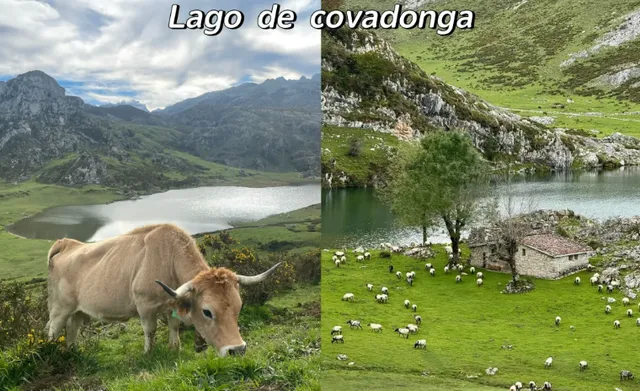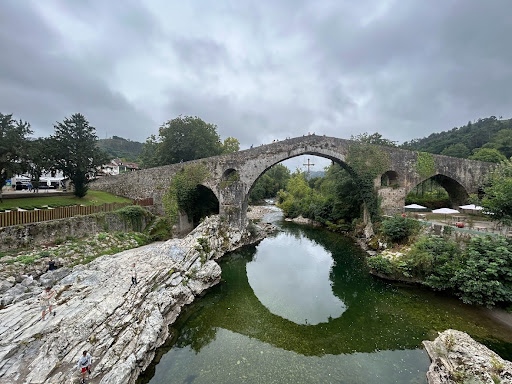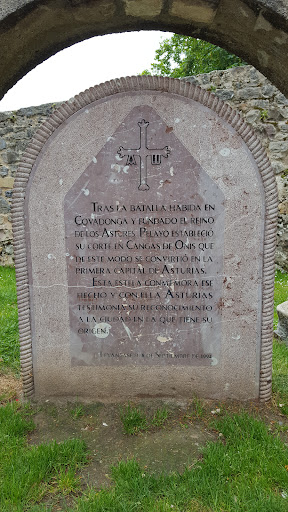El Puente Romano de Cangas de Onís es una antigua construcción situada sobre el río Sella en la antigua capital de Asturias, Cangas de Onís y que separa los concejos de Cangas de Onís y de Parres.
El actual puente, conocido como Puente Romano o simplemente El Puentón para los cangueses, data de la Alta Edad Media (probablemente del s. XIII), aunqoe se asienta sobre otro mucho más antiguo que se remontaría a la época romana. Lo cierto es que sobre este paso de piedra se asentaba el trazado de la calzada romana que unía las localidades de Lucus Asturum (al lado de Oviedo) y Portus Victoriae (actual Santander).
Sin duda este puente, o el inmediatamente anterior a él, sería testigo del levantamiento de Pelayo contra la ocupación musulmana, y sería utilizado para el paso del ejército de Alkama camino de su derrota en Covadonga. Y también contemplaría los primeros años del Reino de Asturias, cuando Cangas de Onís fue sede real, corte y capital del reino, y observaría impasible como los reyes se trasladaban a otras ciudades buscando lugares más estratégicos y más próximos a las fronteras que tenían que defender.
El puente y el inicio del Reino de Asturias son los elementos más importantes para la historia de Cangas de Onís. Por este motivo ambos elementos se integran en el escudo municipal: una cruz de roble sobre la media luna en señal de la victoria de Covadonga, colocados sobre el Puente Romano, y con una inscripción alrededor con la leyenda MINIMA URBIUM, MAXIMA SEDIUM (la más pequeña ciudad fue la máxima sede).
Es del todo probable que la facilidad del paso del río Sella en este punto condicionase la construcción del puente, y este hecho fue determinante para el surgimiento del núcleo de Cangas de Onís. De hecho, el puente y la calzada superior definen el eje urbano marcado por la Calle San Pelayo y su continuidad en la Calle Mercado, las que serían las principales calles hasta la construcción del nuevo puente y la nueva calle a finales del s. XIX.
El puente, que originalmente contaba con 7 arcos, tuvo que ser restaurado en sucesivas ocasiones y a lo largo de todos los siglos de su existencia. En época moderna destacan las restauraciones de 1876 y la de 1940 - 1943, pero hay que resaltar que en estas restauraciones se encontraron piezas de arcos medievales utilizados como relleno entre sus muros. Aún hoy en el segundo arco de la derecha se puede localizar a simple vista la basa de una columna medieval reaprovechada de una iglesia anterior. Junto a su muro izquierdo se ha reconstruido un arco de medio punto con las piezas rescatadas de su interior. Este arco sirve hoy para enmarcar la estela que rinde homenaje a Cangas de Onís como capital del antiguo Reino de Asturias y sede real.
Del arco central pende una réplica a gran tamaño de la Cruz de la Victoria, símbolo de Asturias. Este detalle decorativo tiene su origen en el año 1939 cuando, tras su exilio obligado en París, regresa a España y a su sede de Covadonga la imagen de La Santina. Para recibirla en Cangas de Onís se construyó sobre el puente nuevo un arco de triunfo y se engalanó todo el entorno, utilizando entre otros motivos una Cruz de la Victoria que, desde entonces, luce en el centro del puente.
El puente fue declarado Monumento...
Read moreWorth a visit. The Roman Bridge of Cangas de Onís, also known as the bridge, is an ancient construction located over the Sella River in the ancient capital of Asturias, Cangas de Onís and that separates the municipalities of Cangas de Onís and Parres.
Although it is known as the Roman bridge, its construction was during the Early Middle Ages. Some sources date it during the reign of Alfonso XI of Castile and León. With its famous banked arch and two other smaller arches that are unequal, this bridge could well be a reconstruction of a previous one that dates back to Roman times, although there is no proof of this. It is true that the layout of the Roman road that linked the towns of Lucus Asturum (next to Oviedo) and Portus Victoriae (current Santander) was established.
The bridge and the beginning of the Kingdom of Asturias are the most important elements for the history of Cangas de Onís. For this reason both elements are integrated into the...
Read moreKnown as the Roman Bridge of Cangas de Onís, the “Puente Vieyu” or “Puentón”, this is one of the best-known symbols of the Principality of Asturias.
Although this site may have been used in Roman times to cross the Sella River, and this may have been the reason for the foundation of Cangas de Onís, the first capital of the Kingdom of Asturias, in fact the current "Roman Bridge” dates to mediaeval times, possibly to the end of the 13th century.Its stylised and graceful outline, and the line of the arches take us back to a Romanesque style in transition to Gothic. It has three slightly pointed arches. The central, under which the river flows, is by far the biggest and is cambered. The two on each side are of different sizes.From the central arch hangs a reproduction of the famous Victory Cross, a work of precious metal dating to the start of the 10th century that is kept in...
Read more

